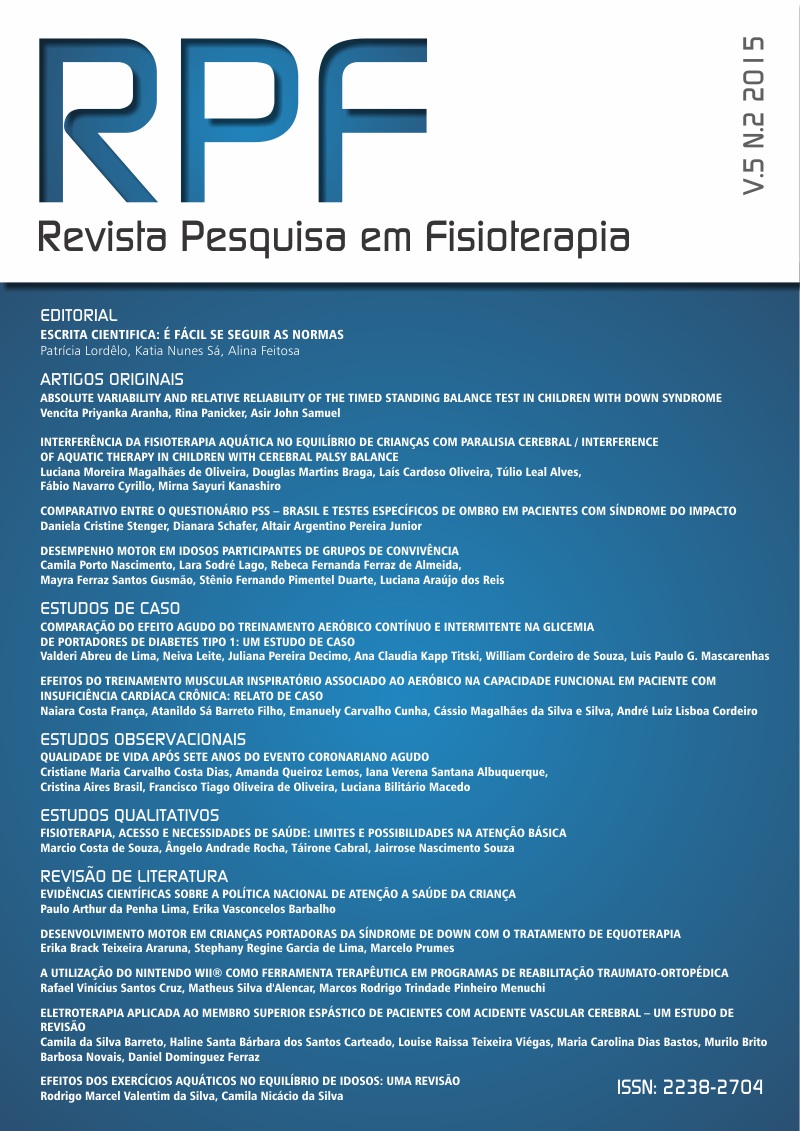ABSOLUTE VARIABILITY AND RELATIVE RELIABILITY OF THE TIMED STANDING BALANCE TEST IN CHILDREN WITH DOWN SYNDROME
DOI:
https://doi.org/10.17267/2238-2704rpf.v5i2.642Palavras-chave:
Adolescent, Balance, Down syndrome, Reliability, Static balance, Test-retestResumo
Background: Reliability of an instrument or clinical test should be known in the field of rehabilitation medicine. But the reliability of most of clinical test to be used among pediatric population with disabilities is yet to be known. One among them is the timed standing balance test. Aim: To determine the minimal detectable change at 95% confidence (MDC95)for the static and dynamic standing balance test in children with Down syndrome (DS). Methods: A sample of nine (09) children with DS, aged between 8 and 17 years were recruited randomly from the recognized special school. Children with DS who were able to understand and obey simple commands were selected and noted their anthropometric measurements. Standing balance was assessed using timed unipedal stance on a hard floor for static and on foam with uniform density for dynamic balance. Standing balance was assessed thrice with an interval of minimum two (02) days in four conditions, Eyes Open Static (EOS), Eyes Closed Static (ECS), Eyes Open Dynamic (EOD) and Eyes Closed Dynamic (ECD) to estimate test retest reliability, Intraclass correlation coefficient (ICC). Then standard error of measure (SEM) and minimal detectable change (MDC95) was calculated. Results: Test retest reliability in four conditions, EOS, ECS, EOD and ECD are ICC = 0.93, 0.91, 0.92 and 0.91 respectively while 1.27 s, 1.63 s, 0.58 s and 0.61 s are the MDC95 required in four conditions. Conclusion: Absolute variability and relative reliability of the timed standing balance test in children with DS have been established.
Downloads
Referências
Domholdt E. Rehabilitation Research: Principles and Applications. 3rd ed. StLouis, MO: Elsevier Saunders; 2005.
Portney LG, Watkins MP. Foundations of Clinical Research: Applications to Practice. 2nd ed. Upper Saddle River, NJ: Prentice Hall Health; 2000.
Haley SM, Fragala-Pinkham MA. Interpreting change scores of tests and measures used in physical therapy. Phys Ther. 2006;86:735–743.
Carvalho RL, Vasconcelos DA. Motor behavior in Down Syndrome: Atypical Sensoriomotor Control. In: Dey S. Prenatal diagnosis and screening for Down syndrome. INTECH Rijeka, Croatia 2001. Chapter 3, p.33-39.
Malak R, Kotwicka M, Krawczyk-Wasielewska A, Mojs E, Samborski W. Motor skills, cognitive development and balance functions of children with Down syndrome. Ann Agric Environ Med 2013;20:803-6.
Villarroya MA, Gonzále-Agüero A, Moros-Garcia T, de la Flor Marin M, Moreno LA, Casajús JA. Static standing balance in adolescents with down syndrome. Res Dev Disabil 2012;33:1294-300.
Emery CA, Cassidy JD, Klassen TP, Rosychuk RJ, Rowe BB. Development of a clinical static and dynamic standing balance measurement tool appropriate for use in adolescents. Phys Ther. 2005;85(6):502-14.
Shrout PE, Fleiss JL. Intra-class correlations: uses in assessing rater reliability. Psychol Bull. 1979; 86:420–28.
Stratford PW. Getting more from the literature: estimating the standard error of measurement from reliability studies. Physiother Can. 2004;56:27–30.
Ebrahim AH, Al-Kahky A. Comparative Study of Static and Dynamic Balance of School Age Children with and Without Backpack. Bull. Fac. Ph. Th. Cairo Univ. 2006; 2(2): 107-13
Peeters H, Breslau E, Mol J, Caberg H. Analysis of posturographic measurements on children. Med Biol Eng Comput. 1984 Jul;22(4):317-21.
Ekdahl C, Jarnlo GB, Andersson SI. Standing balance in healthy subjects. Evaluation of a quantitative test battery on a force platform. Scand J Rehabil Med. 1989;21(4):187-95.
Bohannon RW, Larkin PA, Cook AC, Gear J, Singer J. Decrease in timed balance test scores with aging. Phys Ther. 1984;64(7):1067-70.
Hammarén E, Ohlsson JA, Lindberg C, Kjellby-Wendt G. Reliability of static and dynamic balance tests in subjects with myotonic dystrophy type 1: Advances in Physiotherapy. 2012; 14: 48–54.
Riemann BL, Guskiewicz KM, Shields EW. Relationship between clinical and forceplate measures of postural stability. The Journal of Sport and Rehabilitation. 1999;8:71– 82.
Aranha VP, Panicker R, Samuel AJ. Intra-Observer reliability of static and dynamic standing balance test in the children with Down’s syndrome. In: J Alagesan, S Subramanian, A Ramadass, V Mohan, editors. Int J Pharm Bio Sci. Stride 2013: Proceedings of the International Conference on Physiotherapy; 2013 Oct 18-19; Chennai, India. Elsevier; 2013. p. 55.



